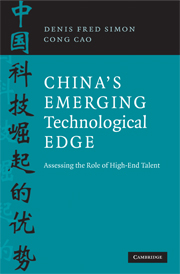Book contents
- Frontmatter
- Contents
- List of Figures and tables
- Acknowledgements
- Abbreviations
- Introduction
- 1 Human resources, technological innovation, and economic growth
- 2 China's talent challenge
- 3 Human resources in science and technology, and their structure and characteristics in China
- 4 Higher education and scientists and engineers in the pipeline
- 5 Utilization of scientists and engineers in China
- 6 “Brain drain,” “brain gain,” and “brain circulation”
- 7 Supply and demand of science and technology talent in China: key drivers
- 8 China's talent in key emerging technologies
- 9 Whither China's talent pool?
- Appendix: Understanding Chinese science and technology human resources statistics
- References
- Index
3 - Human resources in science and technology, and their structure and characteristics in China
Published online by Cambridge University Press: 25 January 2011
- Frontmatter
- Contents
- List of Figures and tables
- Acknowledgements
- Abbreviations
- Introduction
- 1 Human resources, technological innovation, and economic growth
- 2 China's talent challenge
- 3 Human resources in science and technology, and their structure and characteristics in China
- 4 Higher education and scientists and engineers in the pipeline
- 5 Utilization of scientists and engineers in China
- 6 “Brain drain,” “brain gain,” and “brain circulation”
- 7 Supply and demand of science and technology talent in China: key drivers
- 8 China's talent in key emerging technologies
- 9 Whither China's talent pool?
- Appendix: Understanding Chinese science and technology human resources statistics
- References
- Index
Summary
One of the essential ingredients for developing and sustaining a high-performance innovation culture is the deployment and effective utilization of scientific and engineering talent. The next five chapters provide a comprehensive and detailed examination of China's scientific and technical talent pool, including a stocktaking of the current science and technology (S&T) workforce, a thorough analysis of higher education in S&T, a discussion about how S&T talent in China is being utilized, an examination of the “brain drain” phenomenon, and a forecast of the demand and supply for scientists and engineers over the next five years. Taken together, these five chapters present a broad, integrated picture of China's S&T talent situation and its international connections. The analysis is built on field interviews as well as in-depth inspection, scrutiny, and analysis as well as the interpretation of a large volume of primary talent-related data from Chinese sources. It is this overall set of data and the accompanying analysis that forms the core of this book.
This chapter starts with a discussion of terminology and focuses on the application of the internationally used definition – human resources in science and technology (HRST) – and its variations in the Chinese context. Particular attention is paid to the latter – the terminological variations that occur in the Chinese situation – to lay a clear foundation for the subsequent discussion about and analysis of the case of the People's Republic of China.
- Type
- Chapter
- Information
- China's Emerging Technological EdgeAssessing the Role of High-End Talent, pp. 57 - 109Publisher: Cambridge University PressPrint publication year: 2009



